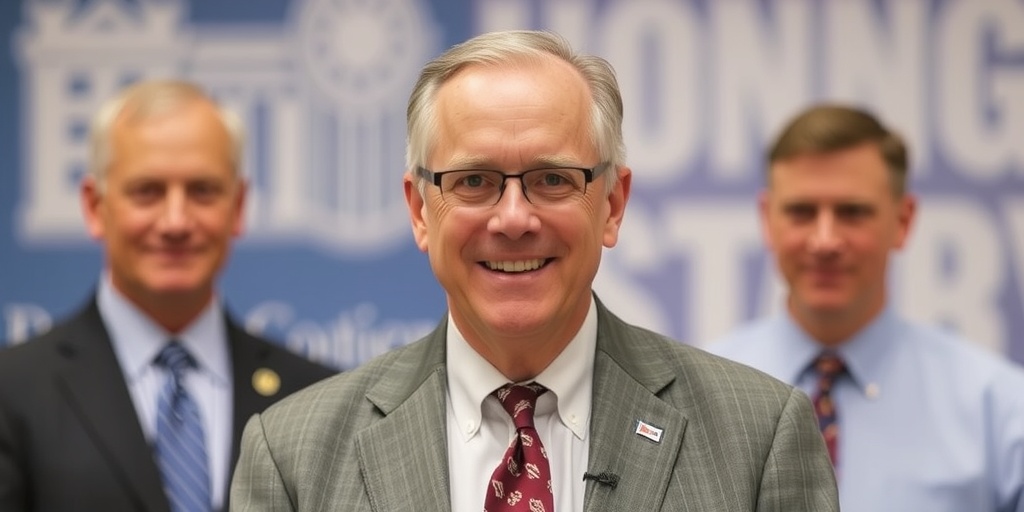Now Reading: Trump Proposes USPS Control Plan
-
01
Trump Proposes USPS Control Plan
Trump Proposes USPS Control Plan

Trump Proposes Merger of U.S. Postal Service with Commerce Department Amid Financial Struggles
In a recent statement, President Donald Trump indicated he is contemplating a significant restructuring of the United States Postal Service (USPS). During the swearing-in ceremony for Howard Lutnick, the newly appointed Secretary of Commerce, Trump revealed his ideas about merging the USPS, which operates as an independent federal agency, with the Commerce Department. This announcement comes as the Postal Service continues to grapple with serious financial challenges and declining service quality.
The President’s remarks were in response to a query about an article published in The Washington Post, which suggested he was planning to dissolve the postal agency’s current leadership. This potential upheaval would place the USPS under the guidance of the Commerce Department, raising questions about the future independence of the agency that has been the backbone of mail delivery in America for centuries.
The United States Postal Service is overseen by a bipartisan Board of Governors, which is composed of up to nine members appointed by the President and confirmed by the Senate. This structure has been designed to limit political influence over the organization, ensuring that members from either political party do not dominate the board. The board is responsible for appointing the postmaster general, who manages the day-to-day operations of the Postal Service. Trump’s proposal could significantly alter this governance framework, potentially consolidating control and altering how decisions are made regarding postal services.
During the event, Trump emphasized his desire to maintain the Postal Service’s functions in a similar manner to its current operations while considering options for its merger or downsizing. "Whether it is a merger, or just using some of the very talented people that we have elsewhere so it does not lose so much — it is losing a tremendous amount of money," he stated. His focus underscores a deep concern regarding the USPS’s financial sustainability, which has produced significant losses over the years.
According to a recent report from the USPS, the agency has recorded nearly $87 billion in financial losses over the past 14 years. The situation worsened during the COVID-19 pandemic when the Postal Service faced tremendous demand for package deliveries, which overwhelming its existing resources and highlighted an outdated mail network. Furthermore, the Government Accountability Office (GAO) has indicated that the Postal Service is at a "high risk" for waste, fraud, and abuse, signaling the urgency for reform.
Historically, the Postal Service was once a Cabinet-level department of the U.S. government. However, it was transformed into an independent agency under President Richard Nixon’s administration in 1971 through the Postal Reorganization Act. This act aimed to shield the agency from political pressures in making crucial decisions regarding rates, appointments, and wages. The reorganization followed a tumultuous period marked by widespread strikes by postal worker unions advocating for better pay and conditions.
In addition to its financial woes, the Postal Service has had to navigate the complex landscape of tariffs, particularly under Trump’s broader economic agenda. An earlier directive from Trump had led to the temporary cessation of deliveries of packages from mainland China and Hong Kong due to revised duty-free handling regulations. However, the USPS quickly reversed this decision after realizing the widespread implications it would have on global trade and delivery efficiency.
Critically, Trump has not missed an opportunity to express dissatisfaction and frustration regarding the Postal Service’s performance. He positioned the agency as an entity that does not meet adequate operational standards, suggesting that it has become a significant liability for the U.S. government: “We want to have a post office that works well and doesn’t lose massive amounts of money,” he stated, indicating a clear intention to enforce accountability and efficiency within the agency.
The discussion surrounding a potential merger between the USPS and the Commerce Department raises substantial questions about the future of mail delivery services in the United States. Critics might argue that such a move could jeopardize the independent status of the USPS, while proponents may point to the potential for revitalizing an agency in dire financial straits. As the situation continues to develop, the implications of Trump’s remarks will likely be scrutinized by policymakers, stakeholders, and the American public alike. The USPS remains a critical service for millions of Americans, and its future operations will be a vital topic of debate in the coming months.
Stay Informed With the Latest & Most Important News
Previous Post
Next Post
-
 01New technology breakthrough has everyone talking right now
01New technology breakthrough has everyone talking right now -
 02Unbelievable life hack everyone needs to try today
02Unbelievable life hack everyone needs to try today -
 03Fascinating discovery found buried deep beneath the ocean
03Fascinating discovery found buried deep beneath the ocean -
 04Man invents genius device that solves everyday problems
04Man invents genius device that solves everyday problems -
 05Shocking discovery that changes what we know forever
05Shocking discovery that changes what we know forever -
 06Internet goes wild over celebrity’s unexpected fashion choice
06Internet goes wild over celebrity’s unexpected fashion choice -
 07Rare animal sighting stuns scientists and wildlife lovers
07Rare animal sighting stuns scientists and wildlife lovers





















